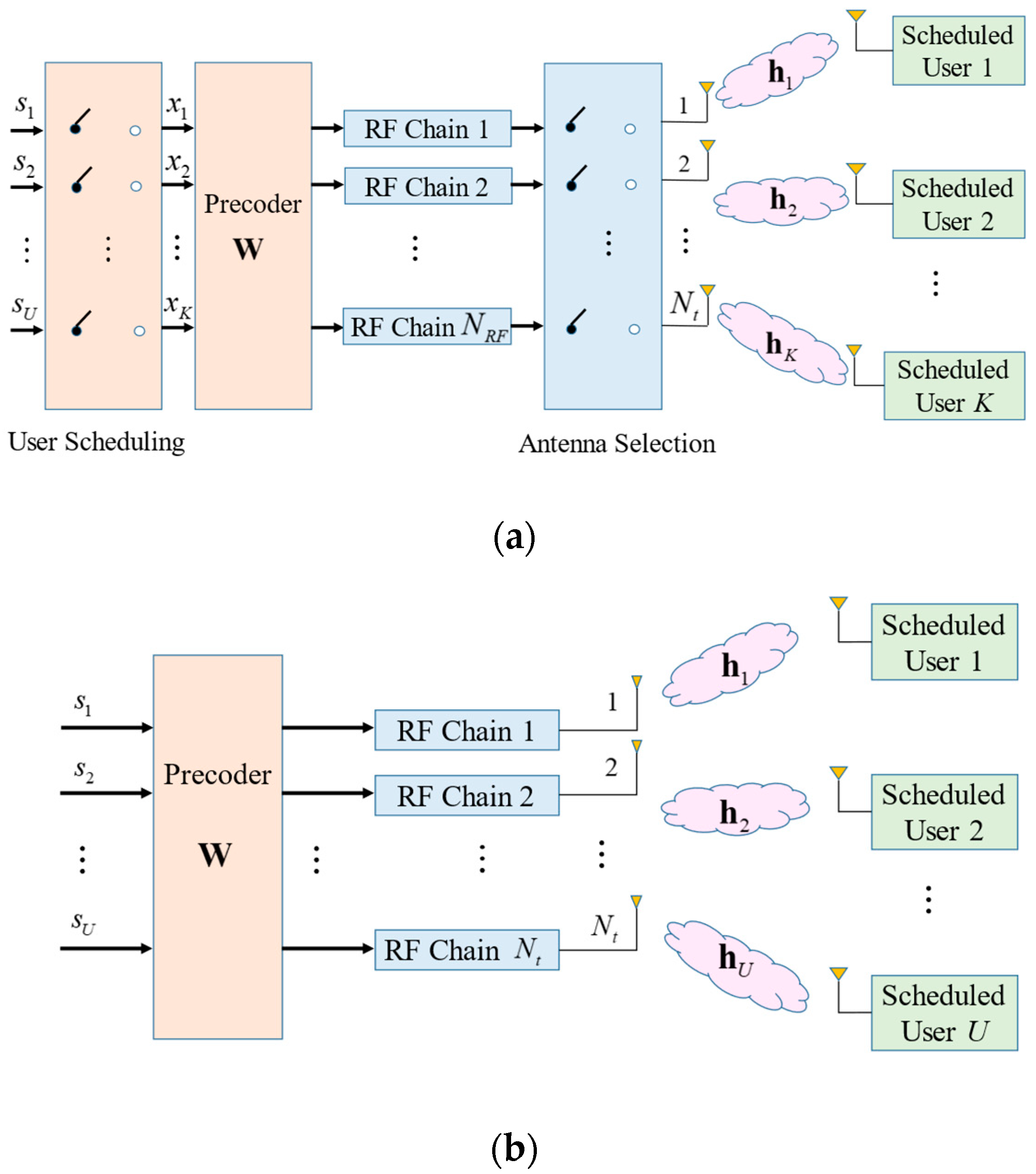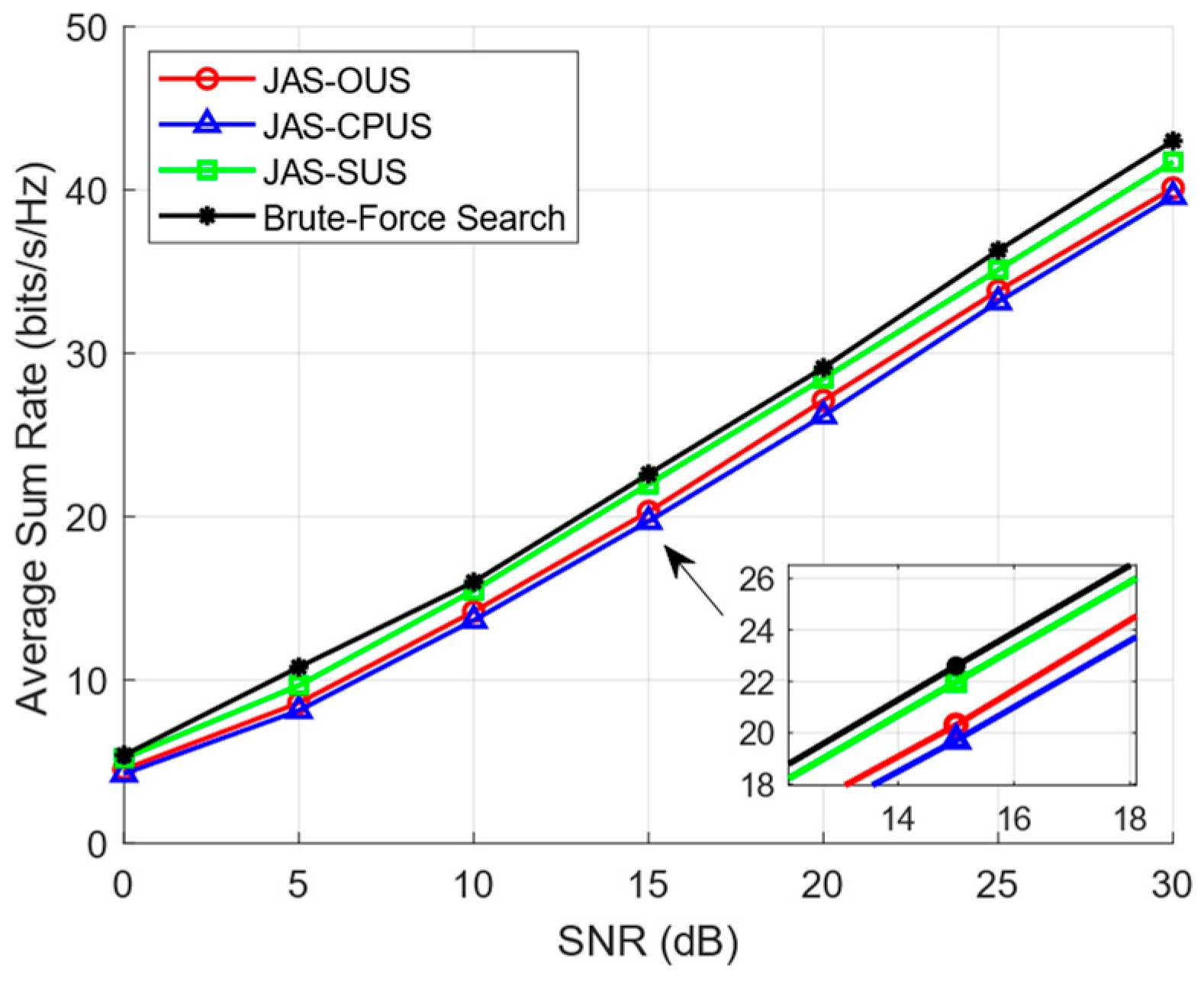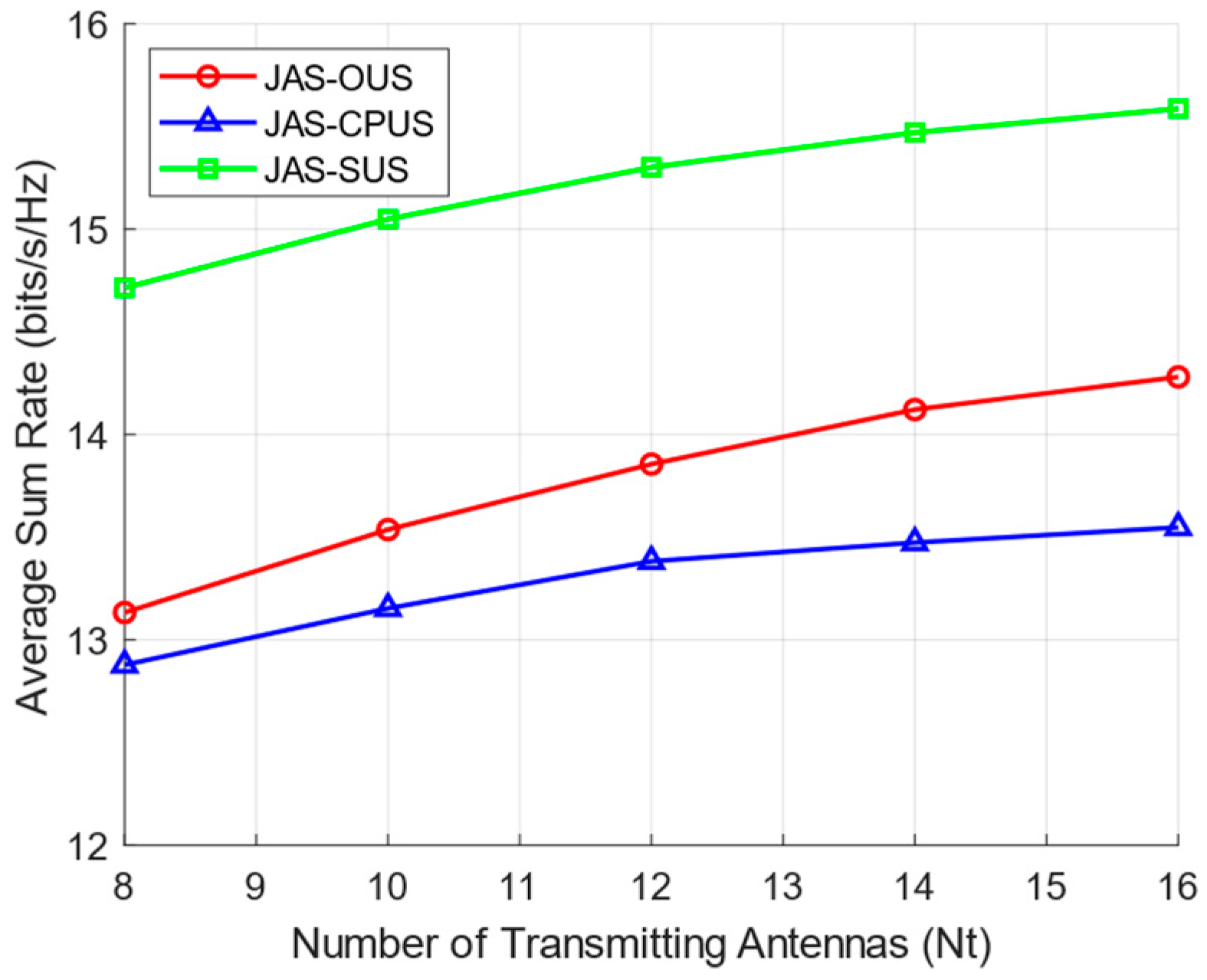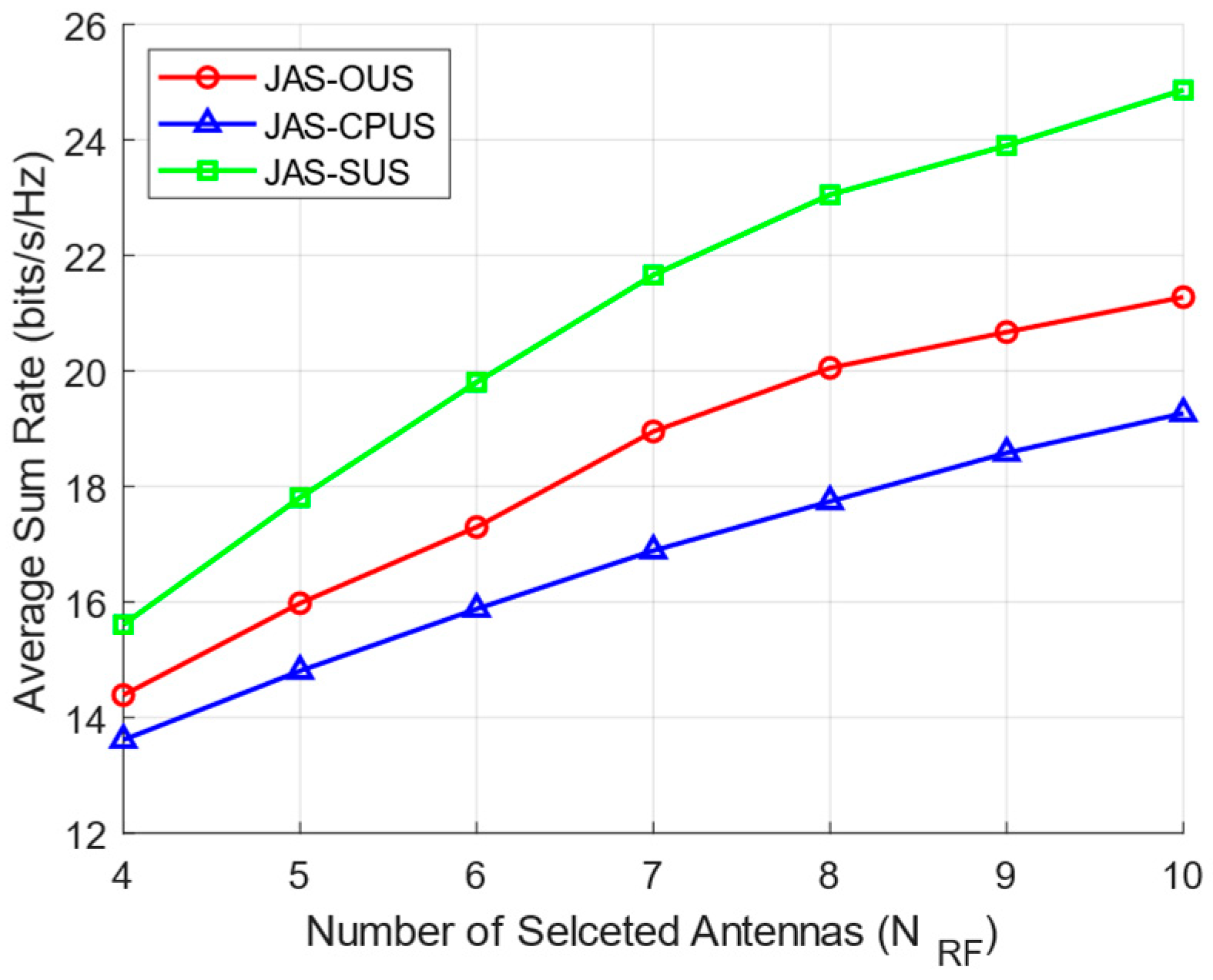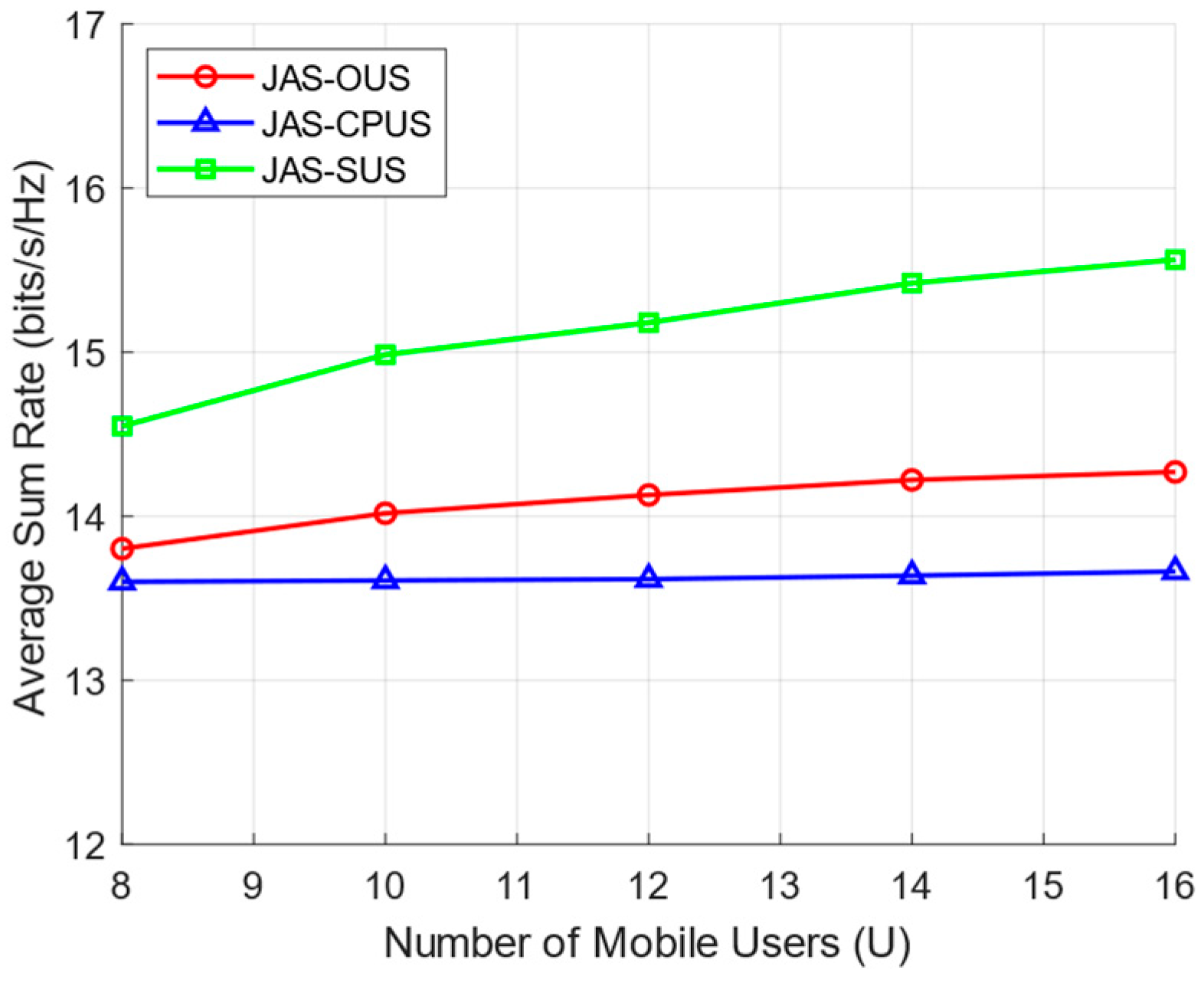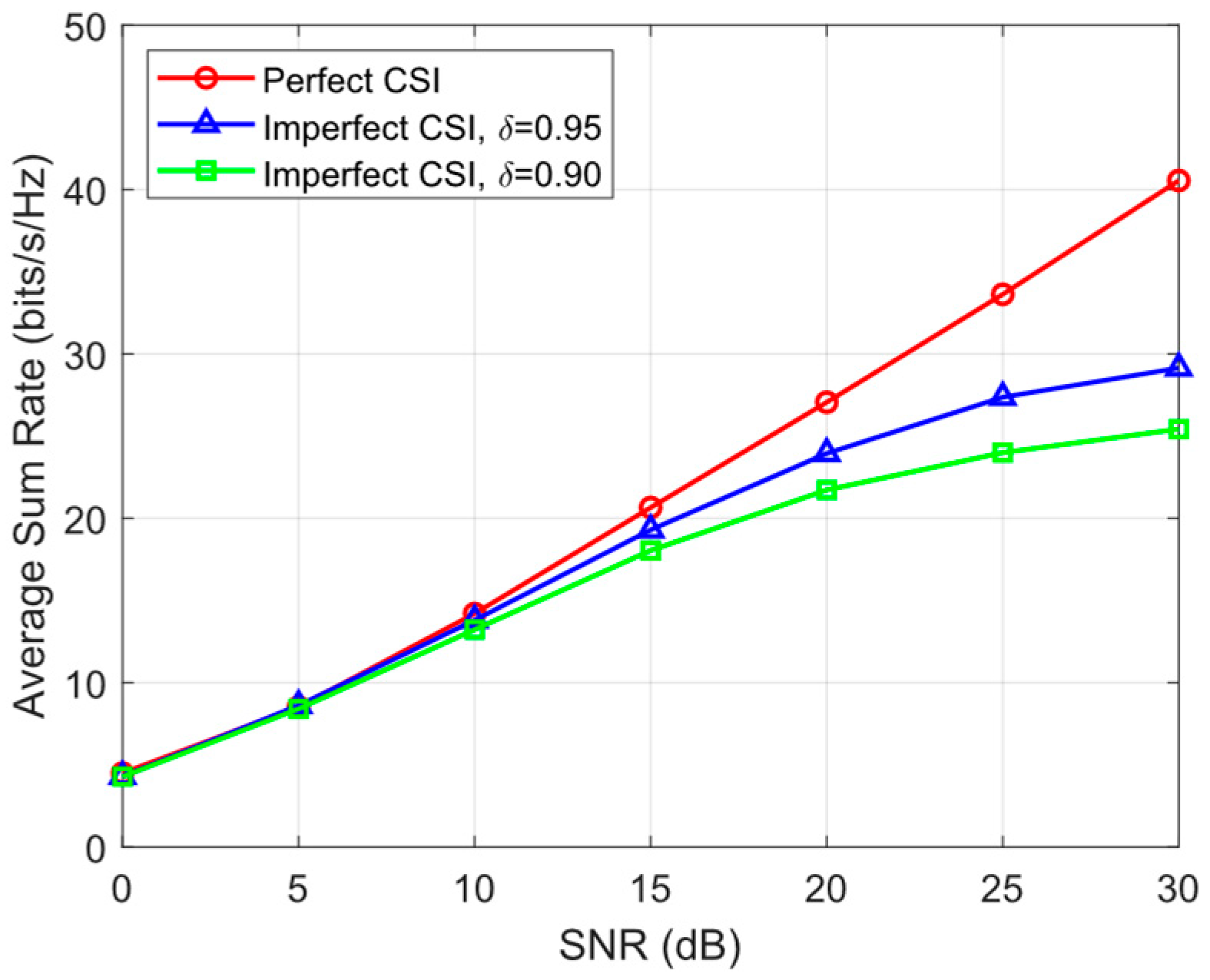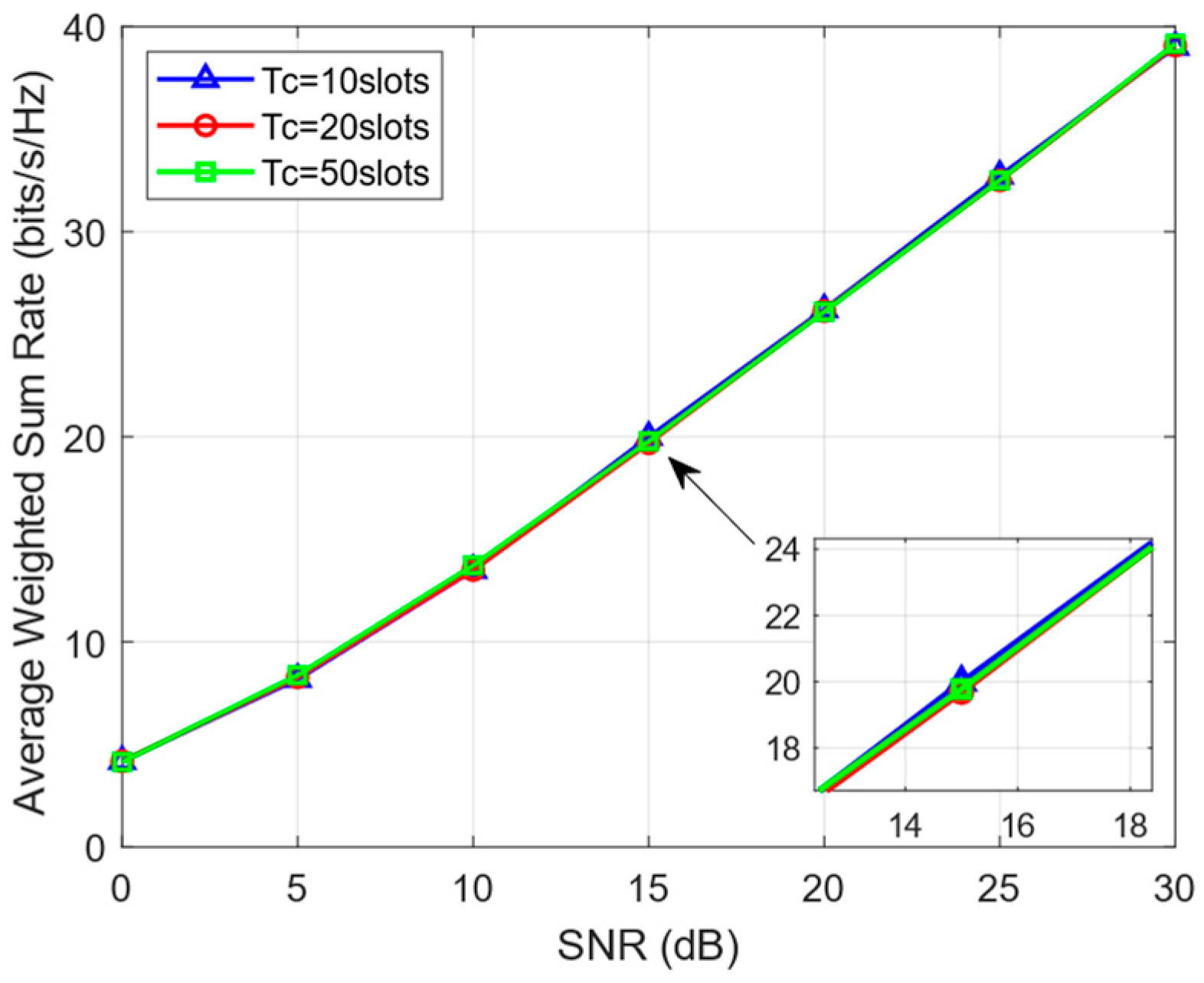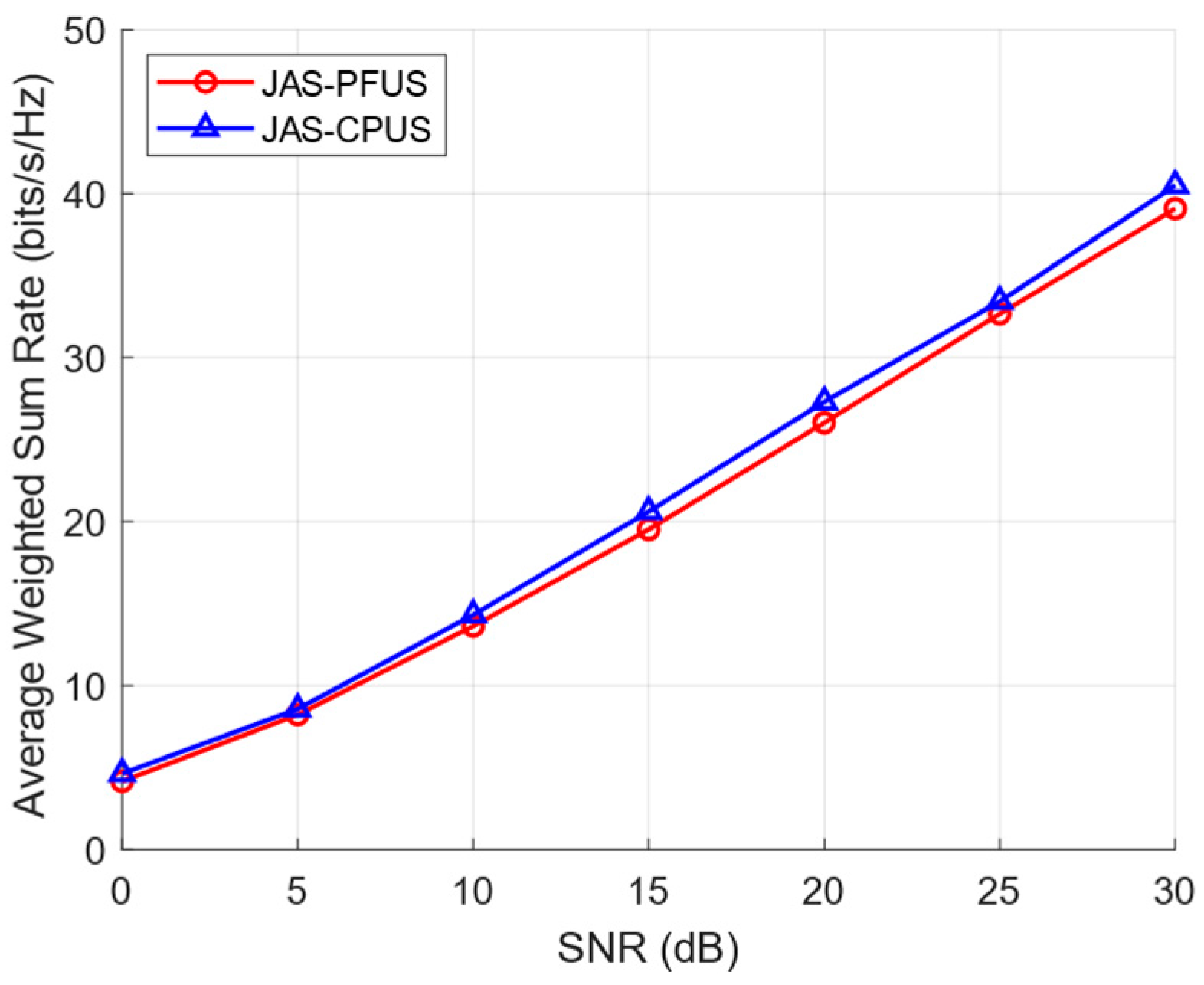1. Introduction
Massive MIMO technology leverages a large number of antennas to improve communication performance. By deploying numerous antennas at both the base station and user sides, this technology enhances signal robustness against interference, increases transmission rates, and improves user connectivity [
1,
2,
3]. Due to its massive connectivity, high energy efficiency, and low latency, massive MIMO has become one of the key technologies for building networks such as the Internet of Things (IoT) [
4,
5].
However, in a massive MIMO system, each transmission antenna is paired with an individual RF chain, resulting in the number of RF chains being equal to the number of antennas. This setup leads to increased computational complexity and power consumption. A major solution is to perform transmission antenna selection. In this architecture, only a limited number of RF chains are deployed, and a corresponding number of antennas are activated for communication based on the available RF chains [
6,
7]. By adopting this approach, both power consumption and latency are significantly reduced. Notably, low power consumption and low latency are critical performance metrics for 5G and beyond 5G (B5G) networks [
8]. Reference [
9] proposed a greedy algorithm for fast selection of transmit or receive antennas, which significantly reduces computational complexity without compromising capacity performance. In the context of massive MIMO, Reference [
10] jointly optimizes precoding and antenna selection. A low-complexity cyclic binary meta-heuristic algorithm is employed to select the optimal antenna combination, thereby enhancing energy efficiency while maintaining spectral efficiency.
In addition, user scheduling plays a crucial role in multi-user large-scale MIMO systems, as it enhances multi-user diversity gain and improves communication efficiency [
11]. Reference [
12] investigates multi-user scheduling in 6G vehicle-to-everything (V2X) communications. Block diagonalization precoding is employed to eliminate multi-user interference, and a group of users with low correlation and high channel quality is selected for scheduling to enhance the overall channel gain and reduce the bit error rate. Reference [
13] addresses the scheduling problem in multi-user MIMO broadcast channels, where user scheduling and antenna selection are performed under limited feedback conditions to reduce channel feedback overhead.
Furthermore, the combination of antenna selection and user scheduling enables the optimal pairing of antennas and users, resulting in a more favorable channel matrix and improved data transmission rates under the same spectrum resources. User scheduling can reduce inter-user signal interference and optimize the system’s signal-to-noise ratio (SNR). In massive MIMO systems, antenna selection significantly reduces the signal processing burden and hardware cost, contributing to the realization of green communication.
The advantages of antenna selection and user scheduling have led to their widespread application in practical communication scenarios. In 5G/6G massive MIMO base stations, antenna selection is used to reduce the number of RF chains, while user scheduling enables multi-user parallel transmission, thereby improving system throughput. In the IoT, user scheduling controls active nodes to reduce concurrent interference. In V2X and high-mobility scenarios, user scheduling dynamically adjusts the service order based on vehicle speed, location, and service priority, reducing latency and ensuring reliable communication (e.g., for autonomous driving). In unmanned aerial vehicle (UAV) communications, antenna selection enables directional transmission, while user scheduling is carried out based on the ground user density.
In the design of joint antenna selection and user scheduling, the conventional approach is to separate these two processes and implement them in a staged manner. While this strategy reduces computational complexity, it comes at the cost of degraded system sum rate [
14]. In contrast, joint optimization can more effectively exploit spatial resources by selecting the optimal subsets of users and antennas under limited resources (e.g., RF chains, transmit power), thereby maximizing the system’s sum rate.
Successive elimination is a commonly used antenna selection method [
15,
16,
17,
18]. It starts by assuming that all antennas are involved in communication and then eliminates one antenna with the least contribution to the system in each iteration until the desired number of antennas is achieved. Benmimoune et al. propose a joint strategy of base station antenna selection and user allocation in large-scale MIMO broadcast channel, aiming to optimize the total system throughput [
15]. By successively eliminating the antennas with the least contribution to the system and using semi-orthogonal user selection (SUS) algorithm to obtain a set of optimal users simultaneously, a sum rate performance close to the exhaustive search method can be achieved with very low complexity. The user scheduling algorithm is changed in reference [
16]. First, users whose channel singular values are greater than the preset threshold are selected to ensure communication efficiency. Then, a detailed user scheduling is carried out in this user group. The user with the largest singular value is the first scheduled user, and the remaining scheduling users are selected according to the principle of low orthogonality with all the selected users. In reference [
17], a low-complexity suboptimal user allocation approach assisted by a matrix Gaussian elimination method (MGEM) is proposed. The user scheduling scheme is integrated with norm-maximized antenna selection to optimize the sum rate, subject to the constraints of a maximum number of served users and limited transmission power. In reference [
18], a set of transmitting antennas and a group of users which can generate maximum channel matrix eigenvalues are selected at first. Then, the antennas and users are iteratively updated. The worst antenna or user is eliminated at each time and replaced by the antenna or user that contributes most to the sum rate. Finally, a maximum system sum rate can be achieved. The difference in this scheme lies in selecting a suboptimal user group and antenna group in the beginning. The user group and antenna group are constantly optimized to approach the optimal scheme. In reference [
19], the antennas are pre-divided into multiple antenna groups, with the antennas within each group working cooperatively. A greedy strategy is employed to select the optimal group from the candidate antenna groups, while simultaneously scheduling the user group that best matches the selected antenna group. Compared to the traditional per-antenna selection approach, this method significantly reduces the search space.
The primary focus of the above studies is to achieve favorable system sum rate with low computational complexity. In addition, there are studies on different channel state information as well as system models. When only part of channel state information (CSI) is known, a joint antenna selection and user allocation algorithm on the base station side using the partially observable Markov decision processes (POMDP) framework is designed in reference [
20]. At the start of every frame, the transmitter schedules the users participating in communication and selects the corresponding antenna subset to serve each group of users. For massive MIMO downlink time-varying fading channels, Zhu et al. study the problem of weighted average sum rate maximization, while guaranteeing the lowest average sum rate for users [
21]. Adaptive scheduling of antennas and users is implemented through dual and randomized subgradient approach, with a heuristic algorithm applied in each time slot to minimize computational complexity. In a multi-cell large-scale MIMO scenario, a resource-efficient joint antenna and user selection technique leveraging the Adaptive Markov Chain Monte Carlo (AMCMC) algorithm is reported in reference [
22]. The algorithm considers multi-cell interference and selects antennas and user subsets to optimize the cell capacity. In reference [
23], the joint optimization problem in non-orthogonal multiple access (NOMA) systems is investigated. For a multi-band, multi-user scenario, a joint antenna and user contribution algorithm is proposed, which jointly considers the contribution of each antenna’s and each user’s channel gain to the overall channel gain. The proposed method is shown to be more effective in scenarios with high user density and a large number of antennas. All the above studies involve antenna selection on base station side. Sigdel et al. investigate antenna selection on user side in [
24]. A user grouping strategy utilizing subspace similarity is proposed, with the goal of selecting users with better spatial compatibility to improve the system throughput. Furthermore, to address the issue of zero rates for certain users caused by user scheduling, a proportional fairness (PF) scheduling scheme is introduced.
Table 1 lists the aforementioned related works and summarizes their system models, research objectives, and methods.
From the above analysis, it can be seen that the joint antenna selection and user scheduling scheme suffers from the fact that the transmitter always tries to prioritize the allocation of resources to some users with the best channel conditions, thus neglecting the service quality for the remaining participants. This kind of service lacks fairness regarding the system, because some users with poor channel conditions may never be selected to participate in communication.
Compared with traditional maximum-rate scheduling, which prioritizes users with high channel quality, PF scheduling exhibits a notable ability to balance system performance and user fairness. This scheduling strategy dynamically adapts to time-varying channel conditions by jointly considering both the current channel state and the historical resource allocation of users. In each scheduling instance, it compensates users who have not been served for an extended period. By doing so, PF scheduling achieves a trade-off optimal solution that ensures both a high system sum rate and fair service distribution among users. Moreover, PF scheduling is inherently compatible with complex network architectures such as orthogonal frequency division multiple access (OFDMA), multi-user MIMO, and 5G NR. Therefore, after investigating the low-complexity joint antenna selection and user scheduling algorithm JAS-OUS, we propose a transmission scheme named JAS-PFUS, which integrates PF scheduling to ensure fairness in user scheduling.
The key contributions of this paper are outlined below.
A system framework is constructed, where a base station fitted with multiple antennas communicates with several users equipped with one antenna. In order to realize simultaneous antenna and user selection strategy, an optimization task is defined with the goal of maximizing the system throughput. antennas are selected from transmitting antennas, and users are selected from participants at the same instant.
We propose a joint antenna selection and channel orthogonality-based user scheduling algorithm, JAS-OUS, which leverages the spatial selectivity benefit from antenna allocation and multi-user diversity benefit from user allocation correspondingly, to optimize the system sum rate. The key idea of the introduced algorithm is to sequentially remove the weakest antenna, that is, the antenna with the least contribution to the system throughput. Also, the user set having the smallest channel correlation is selected using orthogonality-based user scheduling (OUS) for each antenna removal.
Further, in order to ensure the fairness of user scheduling, an improved PFUS user allocation strategy is introduced with the goal of maximizing the weighted throughout. An adjustable weight is set for each user so that different users are selected for communication in each time slot, which makes sure more users will have the opportunity to be served.
Simulation results and complexity assessments indicate that JAS-OUS has the potential to guarantee a high transmission rate with lower computational complexity. Compared with the traditional non-proportional fairness scheduling algorithm, the proposed JAS-PFUS algorithm shows good fairness and is able to schedule more users in communication without reducing the system sum rate.
The paper is structured as follows. In
Section 2, we introduce the joint antenna selection and user allocation model for multi-user massive MIMO and derive the system throughput expression. The specific JAS-OUS and improved JAS-PFUS algorithms are described in
Section 3. In
Section 4, the simulation data and complexity analysis are given.
Section 5 provides the conclusion of this paper.
We use the following notation throughout this paper: is a matrix; is a vector; is a scalar; is a set. and denote transpose and conjugate transpose, respectively. denotes the cardinality of set and denotes the Euclidean norm of vector . represents the set with element removed. represents the ith row of matrix . denotes the element in the ith row and jth column of the channel matrix .
2. System Model
This paper considers a multi-user massive MIMO communication system, as illustrated in
Figure 1a. The base station is equipped with
transmit antennas, and there are
single-antenna users. To reduce energy consumption and hardware cost while improving the system rate in a multi-user scenario, antenna selection and user scheduling are employed. The original transmitted signal consists of
user information signals, denoted by
. User selection is realized through a switch array, which disables part of the data streams and retains only
streams for transmission, forming the signal
. This selected signal is then digitally precoded to eliminate inter-user interference. The precoded signal is converted from digital to analog by
RF chains, where
. Finally, the signal is delivered to the transmit antennas through an RF switch array, which deactivates part of the antennas and only retains
active antennas for communication. In this way, antenna selection and user scheduling are jointly accomplished. We define the group of selected transmitting antennas as
and the group of scheduled users as
. The use of switch-based hardware in the system design is due to its compact size, high integration, and reliability, which make it a practical solution for selectively disabling data streams and deactivating antennas.
Figure 1b illustrates a conventional fully digital system. In this system, neither user scheduling nor antenna selection is performed. The absence of user scheduling prevents the exploitation of multi-user diversity gain, resulting in a degradation of the average system throughput. Moreover, if the users’ channels are highly correlated, transmitting signals to multiple users simultaneously will lead to severe inter-user interference. The absence of antenna selection implies that each antenna in the system is connected to a dedicated RF chain, i.e.,
, resulting in an extremely high hardware cost and power consumption. In contrast, in the system shown in
Figure 1a, only the selected antennas are equipped with complete RF chains (e.g., digital-to-analog converters/analog-to-digital converters, amplifiers), while the remaining antennas can be ignored, i.e.,
. This reduces the number of RF chains, thereby lowering hardware cost, reducing power consumption, and simplifying signal processing complexity. Furthermore, when certain antennas suffer from hardware faults or poor channel conditions, the system can still maintain robust performance by selecting antennas in better states, thereby improving overall system robustness.
In the antenna selection and user scheduling system,
denotes the data streams sent to
scheduled users. After user scheduling and antenna selection, the received signal for
users could be represented as
is the channel matrix formed by all scheduled users and the selected antennas, where
stands for the channel state response between the base station and the scheduled user
.
is considered to be an independent and identically distributed Rayleigh fading channel. To reduce the interference among different users, the forced-zero precoding is used [
25].
is the precoding matrix and
.
denotes the noise vector,
.
Since zero-forcing precoding is employed, the inter-user interference is eliminated. Then, the signal obtained by the scheduled user
can be written as
The SNR at the scheduled user
is
where
denotes the user’s allocated power and
is the noise power.
The highest achievable rate for the scheduled user
is
Further the total throughput expression can be calculated as [
25]
3. Methods
3.1. Problem Formulation
In order to optimize the joint antenna selection and user allocation, the maximization problem is formulated, which aims to select antennas from transmitting antennas and select users from all users to obtain a maximum sum rate.
The joint antenna selection and user allocation problem is formulated as
where
denotes the overall transmission power.
is determined by water filling method.
The optimization objective of the water-filling method is to determine the power allocated to each scheduled user in order to achieve a considerable system sum rate [
26].
3.2. Joint Antenna Selection and Orthogonality-Based User Scheduling
Within this subsection, the JAS-OUS algorithm is introduced, which takes advantage of the spatial selectivity and multi-user diversity, to achieve maximum system sum rate. The basic idea of the introduced scheme is to remove the antenna contributing the least to the system in each iteration. At the same time, the users who exhibit good orthogonality in each iteration are selected to form a subset of users. The algorithm is terminated when the final number of selected antennas is .
The algorithm takes the channel matrix
as input and adopts the classical successive elimination method for antenna selection. It begins with initialization, assuming that all transmit antennas are initially selected, i.e.,
. Then, the algorithm performs
iterations, where in each iteration, one antenna with the least contribution is removed. Eventually, only
antennas are retained for signal transmission. In each iteration, all currently active antennas are examined. For each antenna, it is temporarily deactivated, and the OUS algorithm is used to determine the best user group under the current antenna configuration. Based on the selected antenna–user combination, the system sum rate is computed. By comparing the sum rates across all possible antenna deactivations, the antenna whose removal results in the highest sum rate is identified as having the least contribution to the system and is thus removed. After
iterations, the final set of selected antennas
and the set of scheduled users
are obtained. The pseudocode of JAS-OUS is given by Algorithm 1.
| Algorithm 1. JAS-OUS |
Input:
Channel matrix ;
Number of RF chains ;
Transmit antenna ;
1: Initialization:
;
;
2: while do
;
3: for each in , do
;
choose users using OUS ;
;
4: if , then
;
;
end
end
5: ;
;
end
Output:
the set of selected antennas ;
the set of scheduled users |
The user scheduling part is given by the orthogonality-based user scheduling algorithm. It takes channel
as input, which is formed by removing the current
ith transmitting antenna, and finally outputs the group of scheduled users
, which contains
users. First, initialization is performed so that
is an empty set. The first user is scheduled according to a rule that selects the one with the maximum channel power. Next, scheduling is performed for the rest of the users. At each iteration, a user is selected to be included in set
. The selection criterion is to minimize the orthogonality coefficient between the current round’s selected user and all previously chosen users, i.e., to ensure good orthogonality between this selected user and the previously selected users. The operation is repeated until
users are selected to form the final set of scheduled users. Algorithm 2 provides the pseudocode of OUS.
| Algorithm 2. OUS |
Input:
;
;
1: Initialization:
;
;
;
;
;
;
;
;
do
;
do
;
end
;
;
;
;
;
end
Output:
|
3.3. Proportional Fairness Based Joint Antenna Selection and User Scheduling
The user scheduling scheme aiming at sum rate maximization has the shortcoming that the base station always tries to prioritize the allocation of resources to some users with the best channel conditions, thus ignoring the service levels for the remaining users. This kind of service is unfair to the whole system, since some users with poor channel conditions will never be selected to participate in communication. Proportional fair scheduling, on the other hand, schedules different users in each time slot according to user weights, and more users can be guaranteed to participate in the communication during the whole communication process, thus achieving the balance between communication efficiency and fairness. Therefore, we introduce a joint transmitting antenna selection and proportional fair user allocation scheme to schedule more users during the whole communication process.
In user scheduling for communication systems, to ensure user fairness while improving system capacity, several fairness-oriented scheduling strategies are commonly employed in addition to PF scheduling. These include round-robin scheduling, max-min fairness scheduling, and weighted fair queuing, among others. Round-robin scheduling allocates the channel to users in a fixed cyclic order, regardless of their current channel conditions. It is simple to implement and offers good user fairness, but tends to ignore channel quality, resulting in lower system throughput. Max-min fairness scheduling prioritizes users with the lowest current transmission rate, maximizing their resource allocation. This approach is especially favorable to low-rate users and is suitable for scenarios with strict quality of service (QoS) requirements, though it may sacrifice overall system throughput. Weighted fair queuing allocates resources based on assigned weights reflecting user priorities or data rates, offering a flexible mechanism to meet differentiated QoS demands. Among these methods, the adopted PF scheduling achieves a balance between fairness and efficiency, ensuring acceptable fairness across users while still maintaining a high system sum rate.
In order to fully reflect the differences between users, we first define a weight for each user, indicating the importance of the user. Assuming the rate of user
during the current time slot
is
and the average rate for the whole period is
. The weight
for user
is expressed as
The average rate of every single user must be renewed to adjust the user weights, and the update rule is shown as follows [
27],
denotes the update time window parameter or is understood as the number of time slots. It represents the average rate is calculated over a period of time. The update time window parameter is determined by actual scenario. When is large, the calculation of a user’s average rate needs to take into account the rate value of a long period of time in the past, which is more likely to reflect the long-term fairness. When is small, it indicates that the calculation of a user’s average rate only takes into account the rate value of more recent time slots, which is not universal.
In addition, when a user is always scheduled to participate in communication, its average rate will keep increasing. According to the expression of user weight, with the increase in average rate, the user weight will decrease, which means that the user is less important. On the other hand, if a user is not always scheduled, its average rate will keep decreasing and the corresponding weight will increase, which improves the importance of the user and increases the possibility that he is scheduled. Therefore, by adaptively adjusting the user weight, more users can be scheduled to participate in communication.
Due to the introduction of user weight parameters, the final objective function of joint antenna selection and user allocation needs to be adjusted accordingly. By adapting the optimization problem to weighted sum rate maximization, we have
where
denotes the weight of the
ith user in the current time slot
.
denotes the rate in time slot
.
and
are the group of selected antennas and the group of scheduled users, respectively.
The pseudocode of the joint antenna selection and proportional fairness user allocation is presented in Algorithm 3. All the user weights are initialized to 1. The Algorithm schedules users first. It utilizes the water filling method to calculate the unweighted rate
of all users in the current time slot
with all transmitting antennas participating in communication. The weighted rate of the
ith user is given by
. Then,
users with the largest weighted rate are scheduled to constitute the set
during the current time slot. Fixing the set of scheduled users
for time slot
, the algorithm utilizes successive eliminating method as Algorithm 1 for antenna selection. The antenna has the smallest contribution to the system throughput is eliminated in each iteration until reaching the specified number of antennas, with a total of
iterations. Once user allocation and antenna selection have been completed, the weights
are updated for next time slot. Lastly, the whole process above is repeated for
times because user allocation and antenna selection are carried out in each time slot.
| Algorithm 3. JAS-PFUS |
Input:
;
;
;
;
1: Initialization:
;
;
;
;
2: User scheduling:
by water filling;
;
3: Antenna selection:
;
4: Weight updating:
;
for next time slot according to (7) and (8);
5: Iteration:
;
Output:
of each time slot;
of each time slot |
It is worth noting that this paper considers a static channel scenario, where the channel is assumed to remain constant throughout the entire communication process. It is also assumed that the base station has already obtained full knowledge of all users’ channels through channel estimation, and utilizes the estimated channel information to perform antenna selection and user scheduling. In practical scenarios, however, communication channels are dynamically time-varying due to factors such as user mobility and environmental changes. As user mobility increases, the time-variability of the channel becomes more pronounced, leading to a shorter channel coherence time. In high-mobility environments, the quasi-static channel model no longer holds, resulting in increased channel estimation errors. Moreover, to cope with the rapid channel variation, more frequent channel estimations are required, which consume additional time-frequency resources due to the increased training overhead.
It should be emphasized that the proposed JAS-OUS scheme remains applicable under such conditions, as it assumes that channel estimation has already been performed and that the base station has access to the necessary CSI, which forms the basis for communication. Based on this channel information, antenna and user optimization can be conducted. The estimation process itself is not the focus of this work; instead, we consider only the data transmission phase. Therefore, as long as the CSI is available, the proposed scheme can be executed.
Of course, to ensure system reliability in practical deployments, it is essential to maintain accurate channel estimation throughout the communication process. Techniques such as shortened CSI update intervals and predictive channel estimation may be employed to track the channel in real time.
5. Conclusions
In this work, we study the joint antenna selection and user allocation problem for multi-user large-scale MIMO systems. In massive MIMO systems, antenna selection and user scheduling are complementary techniques. Antenna selection reduces hardware complexity and energy consumption, while user scheduling enhances system capacity and fairness. Together, they form the core mechanism for system performance optimization, serving as key enablers for the successful deployment of massive MIMO.
In this paper, a low-complexity joint antenna selection and user scheduling scheme is designed for a multi-user system model, which achieves a considerable system sum rate. On this basis, to balance system performance and user service fairness, an improved algorithm based on PF scheduling is proposed. This method ensures fair participation of users in communication with only a slight loss in transmission rate, making it practically meaningful.
The integration of antenna selection and user scheduling serves as a key framework for resource allocation algorithms in wireless communication systems. It enhances the system’s resilience to hardware failures and non-ideal channel conditions, offering a low-complexity, suboptimal alternative to fully connected architectures. This approach is particularly suitable for power-sensitive scenarios such as edge devices, UAVs, and satellite communications, as well as a wide range of multi-user access systems including 5G/6G, IoT, and Wi-Fi networks. Therefore, joint antenna selection and user scheduling holds profound theoretical research value and promising practical significance for future deployments.
